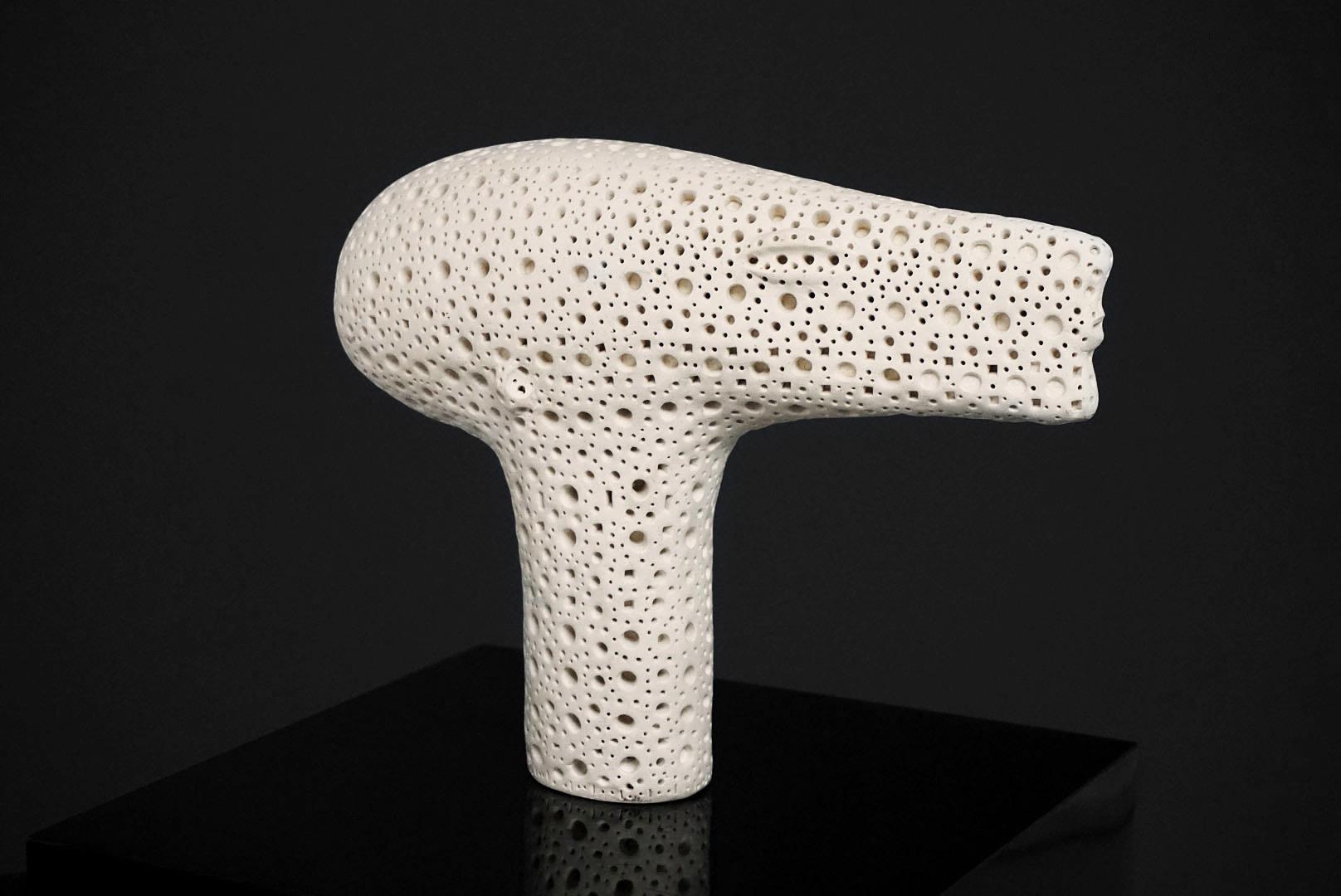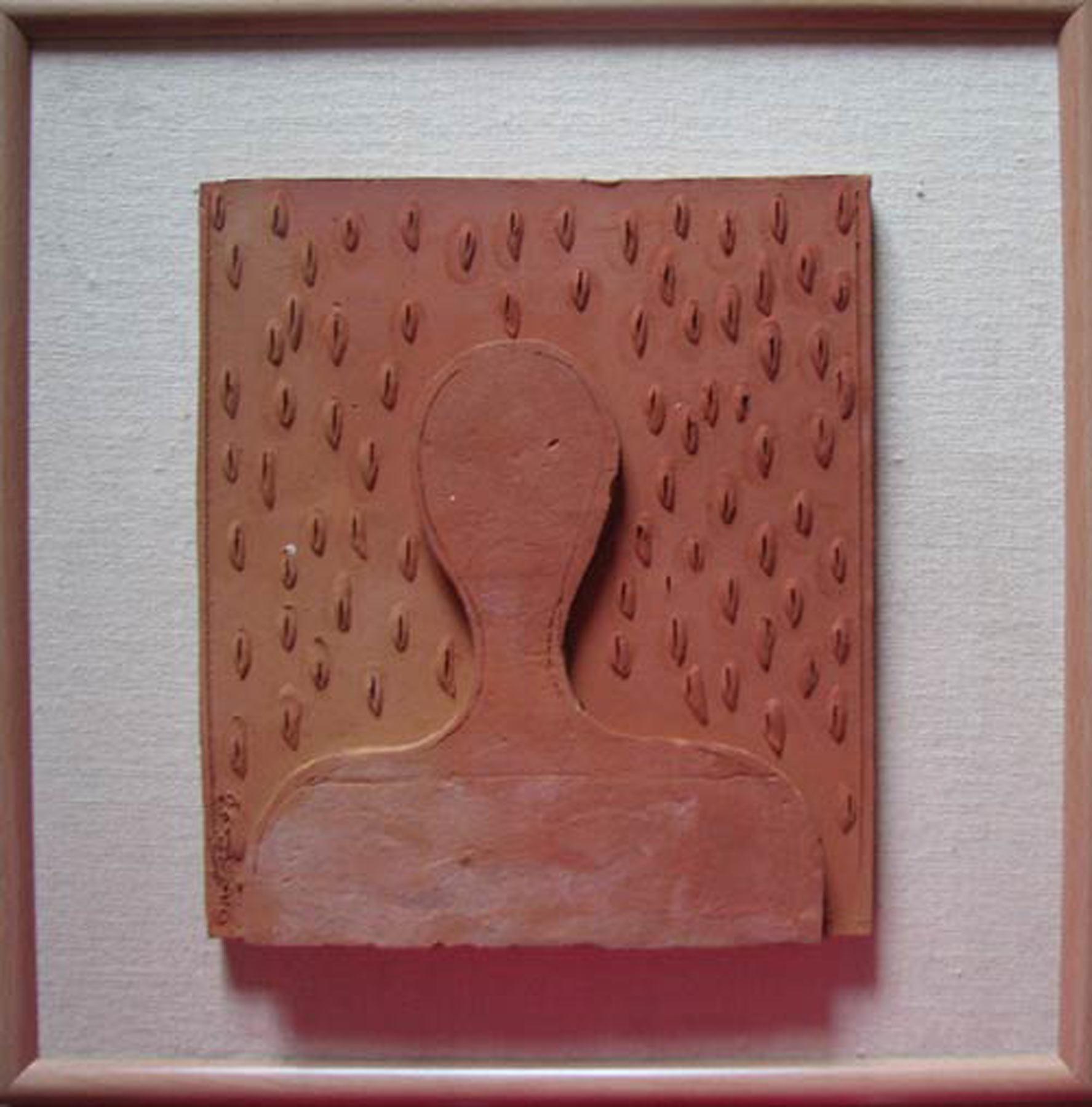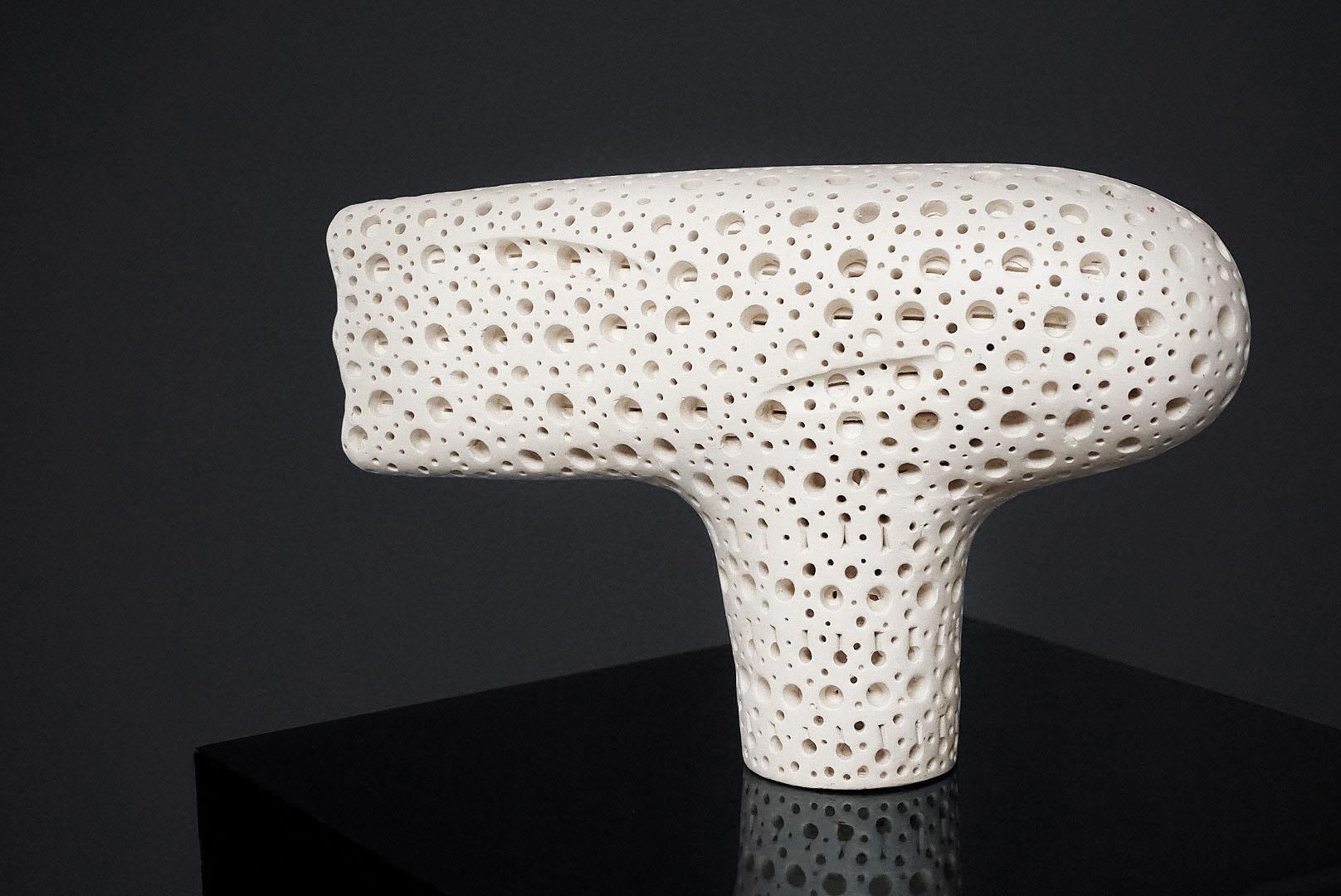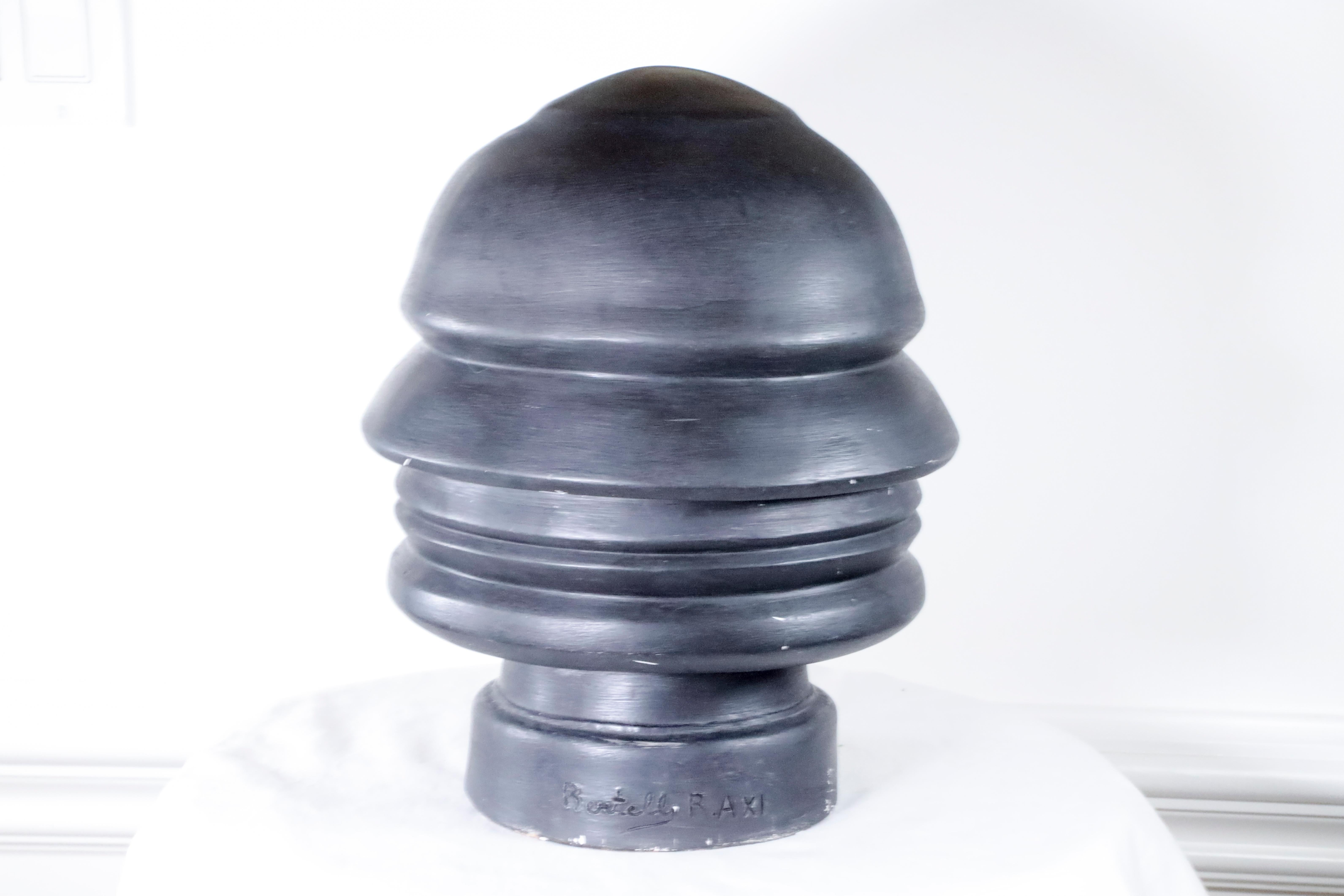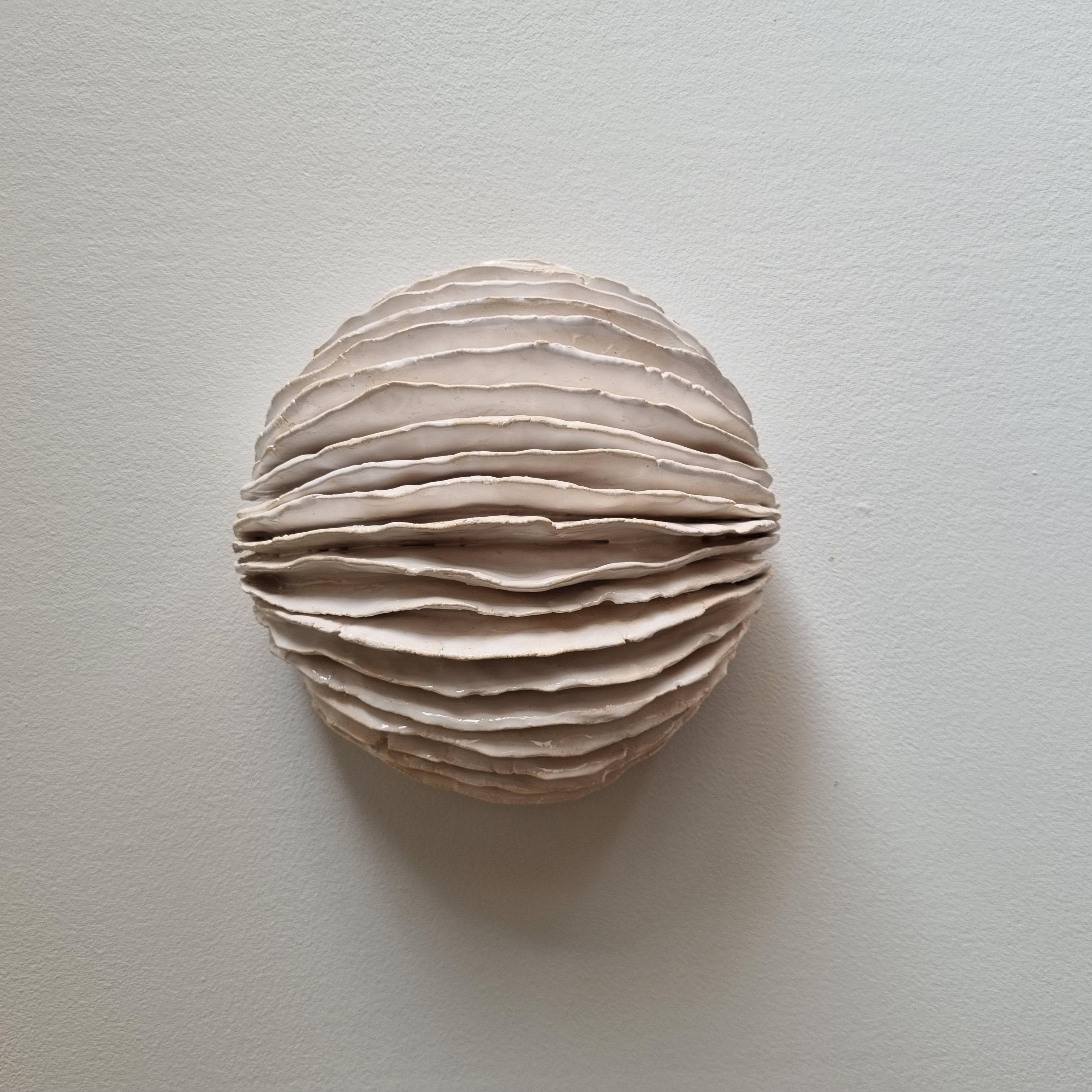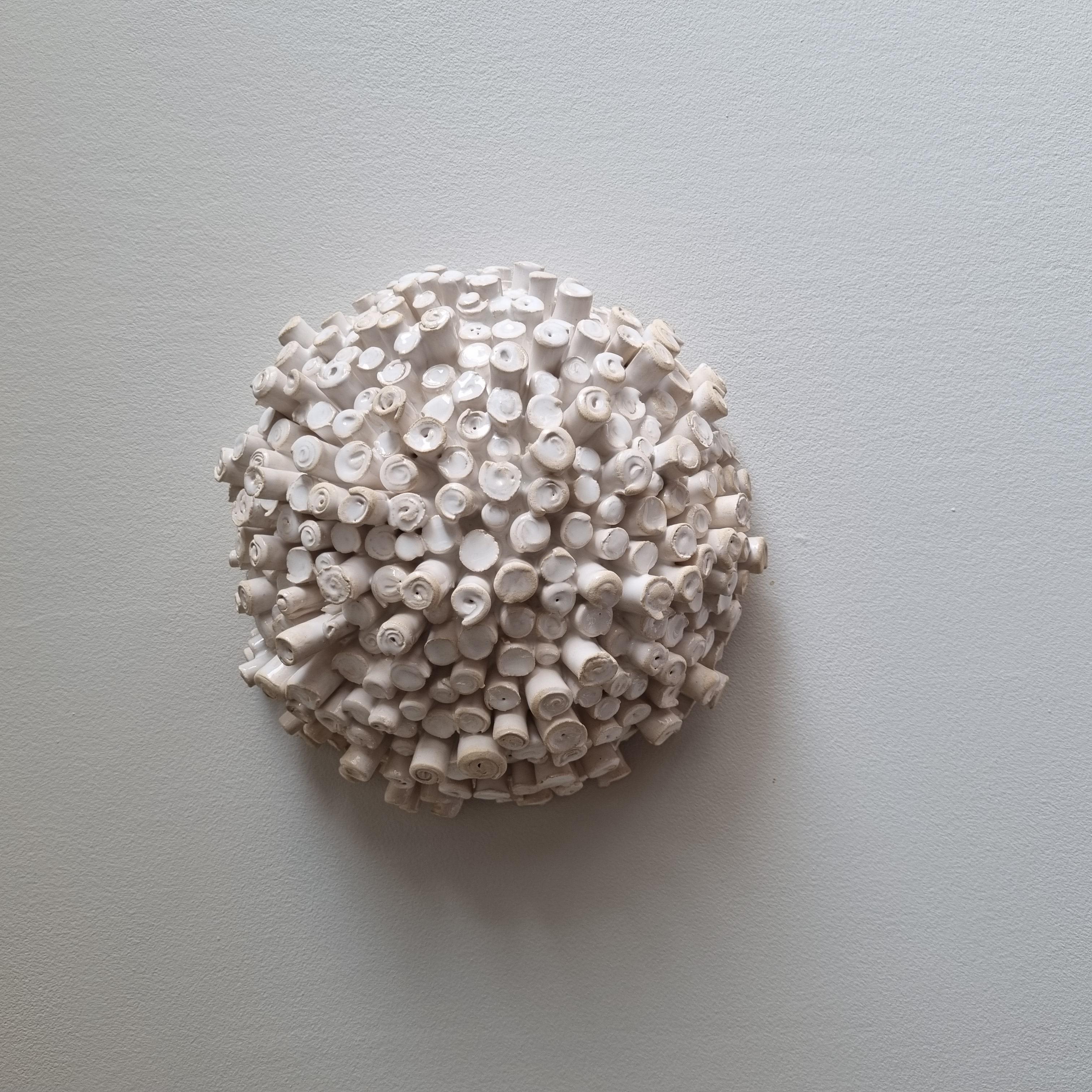Items Similar to Homage à Kahnweiler
Want more images or videos?
Request additional images or videos from the seller
1 of 6
Irmgard BiernathHomage à Kahnweiler1984
1984
About the Item
Irmgard Biernath (1905 Waldheim in Saxony - 1998 Mainz), Hommage à Kahnweiler, 1984. Terracotta relief, burnished red body, 43.5 x 38 cm, mounted on support plate, in wooden frame 57 x 49.5 cm, monogrammed "IB" at lower right.
- Isolated patina losses, but overall good condition, frame slightly bumped.
- The Appearance of Genius-
This homage to Daniel-Henry Kahnweiler shows the gallerist and art theorist as Pablo Picasso portrayed him in his lithographic portrait of 1957.
As an innovative Parisian gallery owner, Kahnweiler had exclusively represented Picasso since 1911, while Picasso had painted his famous portrait of Kahnweiler the previous year as a major work of Cubism. And it is Picasso who appears at the centre of Irmgard Biernath's image. Here, his face echoes the features of the self-portrait he painted in 1907 in the Prague National Gallery.
His eyes are wide open as he gazes into the distance, surrounded by the works of his artistic vision that have already taken shape. On the right is the bronze "Man with Sheep" from 1943, and on the left a flower representing Picasso's painterly work.
Kahnweiler, who was closely associated with Picasso's work, looks at the sculptures on the table in front of him with great attention and admiration. His head joins the sculptures and the flower to form a circle that surrounds Picasso's face like a wreath of honor, so the homage to Kahnweiler is first and foremost a homage to Picasso. As a sculptor inspired by Picasso's work, Irmgard Biernath herself follows in the footsteps of the artistic genius, whose face she makes appear on her relief as on the sweat shroud of Veronica.
About the artist
Irmgard Biernath worked as a teacher in Berlin from 1929. Because of her denunciation in 1941, she voluntarily resigned from teaching. After the Second World War, she followed her true calling as an artist and studied from 1946 at the Berlin-Weißensee School of Art with Bernhard Heiliger and from 1948 at the Nuremberg Academy of Fine Arts, where she was a master student of Hans Wimmer, among others. To earn a living, she taught art at the Anne Frank Realschule in Mainz from 1953 to 1971, for which she created a bust of Anne Frank. From 1958 to 1964 she was also a lecturer at the University Institute for Art and Work Education in Mainz. In addition, she was active at the Volkshochschule (adult education center), where she established the field of art education with her concept "Forming Hands" and left her mark for decades. From the 1960s on, Irmgard Biernath devoted herself more and more to her own work, working exclusively as a freelance artist since 1971.
Irmgard Biernath's artistic estate is housed in the museum of her hometown of Waldheim, where the Irmgard Biernath Foundation is also located.
Irmgard Biernath received numerous awards. Among others, she received the Federal Cross of Merit in 1976, the Rembrandt Medal in 1990, and the Mainz Plate, also in 1990.
Exhibitions
Kennen Sie ...? Biernath! Werke aus dem Nachlass der Bildhauerin Irmgard Biernath, Kulturzentrum Waldheim 2011.
Harmonie und Gleichgewicht im Werk der Irmgard Biernath, Stadt- und Museumshaus Waldheim, 2022.
Selected Bibliography
Irmgard Biernath (Hrsg.): Irmgard Biernath, Mainz 1990.
Marlene Hübel: Irmgard Biernath. Ein Lebenswerk, Mainz 1995.
Saur. Allgemeines Künstlerlexikon, Band 10, München - Leipzig 1995, S. 576-577.
GERMAN VERSION
Irmgard Biernath (1905 Waldheim in Sachsen - 1998 Mainz), Hommage à Kahnweiler, 1984. Terracotta-Relief, brünierter roter Scherben, 43,5 x 38 cm, auf Trägerplatte montiert, im Holzrahmen 57 x 49,5 cm, rechts unten mit „IB“ monogrammiert.
- Sehr vereinzelte Verluste der Patina, insgesamt aber wohlerhalten, Rahmen etwas bestoßen.
- Die Erscheinung des Genius -
Die Hommage an Daniel-Henry Kahnweiler zeigt den Galeristen und Kunsttheoretiker in der Art wie ihn Pablo Picasso in seinem lithographischen Porträt von 1957 dargestellt hat.
Als innovativer Pariser Galerist hatte Kahnweiler Picasso ab 1911 exklusiv vertreten, während Picasso im Jahr zuvor sein berühmtes Porträt Kahnweilers als ein Hauptwerk des Kubismus malte. Und Picasso ist es, der im Zentrum des Bildes von Irmgard Biernath erscheint. Dabei folgt sein Antlitz den Zügen des 1907 geschaffenen Selbstporträts der Prager Nationalgalerie.
Mit weit geöffneten Augen schaut er in die Ferne, während er bereits von den gestaltgewordenen Werken seiner künstlerischen Vision umgeben ist. Rechts neben ihm steht die Bronze „Mann mit Schaf“ aus dem Jahre 1943 und links ist eine Blume zu sehen, die für Picassos malerischen Werk einsteht.
Voller Aufmerksamkeit betrachtet der mit dem Werk Picassos eng verbundenen Kahnweiler die vor ihm auf dem Tisch situierten Skulpturen, zu denen er bewundernd aufblickt. Dabei verbindet sich sein Kopf mit den Skulpturen und der Blume zu einer Picassos Antlitz wie ein Ehrenkranz umgebenden Kreisform, weshalb die Hommage an Kahnweiler vor allem eine Hommage an Picasso ist. Als eine von Picassos Oeuvre inspirierte Bildhauerin tritt Irmgard Biernath selbst in die Fußstapfen des Künstlergenies, dessen Antlitz sie auf ihrem Relief wie auf dem Schweißtuch der Veronika zur Erscheinung bringt.
zur Künstlerin
Irmgard Biernath war ab 1929 Lehrerin in Berlin. Aufgrund ihrer Denunziation 1941 schied sie freiwillig aus dem Schuldienst aus. Nach dem Zweiten Weltkrieg folgte sie ihrer eigentlichen Berufung als Künstlerin und studierte ab 1946 an der Kunsthochschule Berlin-Weißensee bei Bernhard Heiliger und ab 1948 an der Akademie der Bildenden Künste Nürnberg, wo sie unter anderem Meisterschülerin bei Hans Wimmer war. Um den Brotererb zu sichern, war sie von 1953 bis 1971 Kunstlehrerin an der Mainzer Anne Frank Realschule, für die sie eine Büste der Anne Frank schuf. Von 1958 bis 1964 war sie auch Dozentin am Hochschulinstitut für Kunst- und Werkerziehung Mainz. Zudem war sie an der Volkshochschule tätig, wo sie den Bereich Kunsterziehung mit ihrem Konzept der „Formende Hände“ aufbaute und über Jahrzehnte hinweg prägte. Ab den 1960er Jahre widmetet sich Irmgard Biernath zusehend ihrem eigenen Schaffen, um dann ab 1971 ausschließlich als freischaffende Künstlerin tätig zu sein.
Der künstlerische Nachlass befindet sich im Museum ihrer Geburtsstadt Waldheim, wo auch die Irmgard-Biernath-Stiftung ansässig ist.
Irmgard Biernath wurden zahlreiche Ehrungen zuteil. So erhielt sie unter anderem 1976 das Bundesverdienstkreuz, 1990 die Rembrandt-Plakette und ebenfalls 1990 den Mainzer Teller.
Ausstellungen
Kennen Sie ...? Biernath! Werke aus dem Nachlass der Bildhauerin Irmgard Biernath, Kulturzentrum Waldheim 2011.
Harmonie und Gleichgewicht im Werk der Irmgard Biernath, Stadt- und Museumshaus Waldheim, 2022.
Auswahlbibliographie
Irmgard Biernath (Hrsg.): Irmgard Biernath, Mainz 1990.
Marlene Hübel: Irmgard Biernath. Ein Lebenswerk, Mainz 1995.
Saur. Allgemeines Künstlerlexikon, Band 10, München - Leipzig 1995, S. 576-577.
- Creator:Irmgard Biernath (1905 - 1998, German)
- Creation Year:1984
- Dimensions:Height: 17.33 in (44 cm)Width: 14.97 in (38 cm)Depth: 1.97 in (5 cm)
- Medium:
- Movement & Style:
- Period:
- Condition:
- Gallery Location:Berlin, DE
- Reference Number:1stDibs: LU2438213127682

About the Seller
5.0
Vetted Seller
These experienced sellers undergo a comprehensive evaluation by our team of in-house experts.
Established in 2014
1stDibs seller since 2023
7 sales on 1stDibs
Typical response time: 7 hours
- ShippingRetrieving quote...Ships From: Berlin, Germany
- Return PolicyA return for this item may be initiated within 14 days of delivery.
More From This SellerView All
- Madonna del Dito - Heavenly beauty down to the fingertip -Located in Berlin, DEKPM, Madonna del Dito, oval, slightly curved porcelain picture plate by KPM Berlin in fine polychrome onglaze painting, 27 x 22 cm (plate size), 33 x 28.5 cm (frame), unsigned, press...Category
1880s Academic More Art
MaterialsPorcelain, Oil
- Still life with meadow flowers - The beauty of meadow flowers -Located in Berlin, DEJean-Baptiste Robie (1821 Brussels - 1910 ibid.). Still life with meadow flowers. Oil on wood, 24.5 x 18.5 cm (inside measurement), 37 x 31 cm (frame), signed and dated (difficult to...Category
Early 1900s Naturalistic Still-life Paintings
MaterialsCanvas, Oil
- Mary Magdalene - Faith transforms inner into outer beauty and conquers death -By Balthasar DennerLocated in Berlin, DEBalthasar Denner (1685 Hamburg - 1749 Rostock). Mary Magdalene. Oil on copper, 37 × 32 cm (visible size), 45 x 40 cm (frame), signed and indistinctly dated "Denner 17(...)" at centre...Category
1720s Old Masters Figurative Paintings
MaterialsCopper
- In the forest of Durlach - Quiet ripple in a secret place -Located in Berlin, DEFranz Xaver Graessel (1861 Oberasbach/Baden - 1948 Emmering). In the forest of Durlach. 1881. Pencil drawing, heightened with white, on grey-green paper. 33 x 41.7 cm. Signed, dated and inscribed by the artist himself: 'Franz Graessel. Durlach, 12 April 1881". About the artwork The drawing depicts a view of the woods which, as if sharpening the visual focus, remains diffuse at the edges and does not allow the viewer to locate himself in the picture. As a result, the landscape appears to be an apparition, but at the same time it is given real substance by the solidity of the massive arched bridge made of quarry stone. As the main motif of the painting, the bridge, which blends in with nature like an archaic relic, also acts as a visual guide, drawing attention to the white, raised waters of the stream and the surrounding vegetation. The diffusion of perception that takes place there, however, draws the eye back to the bridge and thus to the overall view. This movement initiating a constant alternation of diffusion and concretion, which is the specific tension of the painting that brings the landscape to life. The materialisation and dematerialisation, however, does not take place solely through the eye's wandering through the picture; it is simultaneously linked to the viewer's approach to and distance from the picture, which loses its richness of detail precisely in the close-up, only to reconfigure itself with increasing distance. In this work, which dates from Graessel's studies in Karlsruhe, the artist reflects on the emergence of pictorial objectivity. Here, however, nature is more than a mere motif. The real connection between culture and nature is symbolically expressed by the choice of green paper. The drawing is an impressive testimony to Graessel's mastery of the sprezzatura with which he skilfully applies the most abstract of strokes, which visibly merge towards the centre of the picture. The signature and the exact date prove that Graessel gave this work more than the character of a mere sketch. About the artist Franz Graessel grew up in an environment that was to nourish his later key motifs: his parents' house was a mill. After attending the Karlsruhe Academy of Art from 1878 to 1884, where he studied under Carl Hoff, Graessel continued his training at the Munich Academy from 1886 to 1890 as a pupil of Wilhelm von Lindenschmidt. Trained primarily in genre and portrait painting, he initially portrayed the life of Black Forest farmers. From 1894 he turned increasingly to animal painting, concentrating on the depiction of ducks and geese, which earned him the nickname 'Enten-Graessel'. Graessel's work thus parallels that of Alexander Koester...Category
1880s Naturalistic Landscape Drawings and Watercolors
MaterialsPaper, Chalk, Pencil
- Sunny woodland path - A brightly lit forest path as a space for imagination -Located in Berlin, DEWilhelm Schütze (1840 Kaufbeuren - 1898 Munich). Forest path. Oil on painting board, 30 x 24 cm (visible size), 31 x 26 cm (frame), signed lower left "Wilhelm Schütze". About the a...Category
1880s Naturalistic Landscape Paintings
MaterialsOil, Cardboard
- Two countrywomen with a donkey - Melancholy in an atmosphere of colour -Located in Berlin, DEPierre Louis De La Rive (1753 Geneva - 1817 Geneva). Two countrywomen with a donkey. Oil on canvas, mounted, 27 x 20 cm (visible size), 37 x 31 (frame), monogrammed "P.R." at lower right. About the artwork De La Rive has taken the typical scenes of Dutch landscape genre paintings...Category
1790s Old Masters Figurative Paintings
MaterialsCanvas, Oil
You May Also Like
- Alexander Ney, 'Teacher' Unique Sculpture, 2008By Alexander NeyLocated in New York, NYThe unique minimalist ‘Teacher’ sculpture by visionary artist Alexander Ney is handcrafted using italian white terra cotta, created in 2008. Ney is a contemporary visual artist, work...Category
Early 2000s Contemporary Figurative Sculptures
MaterialsTerracotta
- Terracotta, Plate , Brick, Brown, Black colors by Indian Artist "In Stock"By Gautam DasLocated in Kolkata, West BengalGautam Das - Untitled - 8.5 x 8.5 inches Gautam Das is a master Terracotta and mural Artist. He studied in the Kala Bhavana and currently presides as th...Category
Early 2000s Contemporary Figurative Sculptures
MaterialsTerracotta
- Alexander Ney, 'Guardian' Unique Sculpture, 2012By Alexander NeyLocated in New York, NYThe ‘Guardian’ by visionary artist Alexander Ney was handcrafted using italian white terra cotta in 2008. Ney began his professional career as a highly productive visual artist, as a...Category
2010s Minimalist Figurative Sculptures
MaterialsTerracotta
- Continuous Profile of Mussolini "Profilo ContinuoLocated in Brookville, NYRenato Giuseppi Bertellis Born in 1900 in Lastra a sign and died in Florence in 1974. The title is sometimes given as Head of Mussolini, but is better known as Head of Mussolini (Co...Category
Mid-20th Century Futurist Figurative Sculptures
MaterialsTerracotta
- Abstraction Female - Unique Handmade Modern Glazed Ceramics Wall SculptureBy Monika Zadurska-BielakLocated in Salzburg, ATWeigt of the sculpture 1,25 kg Monika Zadurska-Bielak, Graduated from the studio of Prof. Franciszek Duszeńko at the Faculty of Sculpture of the Acade...Category
2010s Contemporary Abstract Sculptures
MaterialsCeramic
- Abstraction Male - Unique Handmade Modern Glazed Ceramics Wall SculptureBy Monika Zadurska-BielakLocated in Salzburg, ATWeigt of the sculpture 2,15 kg Monika Zadurska-Bielak, Graduated from the studio of Prof. Franciszek Duszeńko at the Faculty of Sculpture of the Acade...Category
2010s Contemporary Abstract Sculptures
MaterialsCeramic
